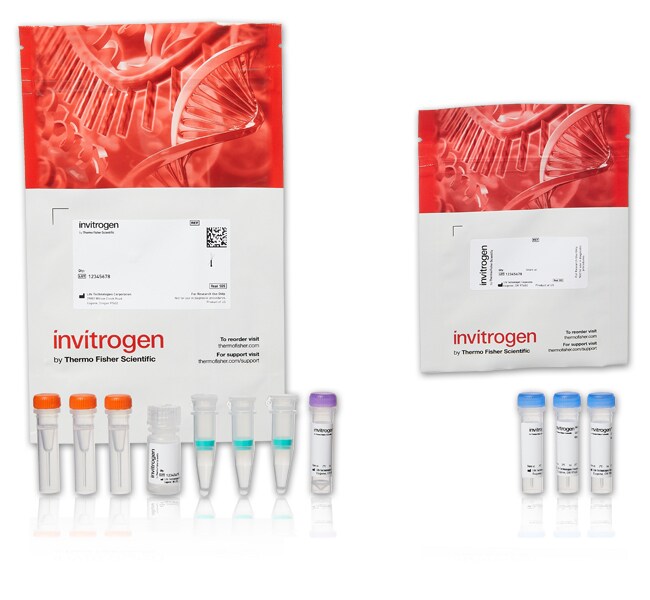Search Thermo Fisher Scientific

Alexa Fluor™ 488 Microscale Protein Labeling Kit
 Promotion
Promotion| Catalog Number | Quantity |
|---|---|
A30006 | 1 Kit |
Microscale Protein Labeling Kits provide a convenient means for attaching a fluorescent label to a small amount of antibody or protein (20–100 μg). The kits are available in four Alexa Fluor™ colors (or biotin) and supply everything needed for three labeling and separation reactions.
Important Features of Microscale Protein Labeling Kits:
- Labeled proteins typically ready to use typically in 2 hr (∼30 min hands-on time)
- Optimized for 20–100 μg of protein with molecular weights between 12 and 150 kDa
- Purified using convenient spin filters with yields between 60 and 90%
- Stabilizing proteins must be removed from the sample before labeling
Stable Reaction Chemistry and Superior Alexa Fluor™ Dyes
In the Microscale Protein Labeling Kits, the reactive dye contains a tetrafluorophenyl (TFP) ester moiety that is more stable in solution than the commonly used succinimidyl (NHS) ester. TFP esters react efficiently with primary amines of proteins to form stable dye–protein conjugates. Compared to traditional dyes, Alexa Fluor™ dyes are brighter, more photostable, and more pH resistant between pH 4 and 10. And generally when using Alexa Fluor™ dyes, higher degrees of labeling can be achieved without intramolecular quenching. For details see Alexa Fluor™ Dyes Spanning the Visible and Infrared Spectrum—Section 1.3.
Learn More About Protein and Antibody Labeling
We offer a wide selection of Molecular Probes™ antibody and protein labeling kits to fit your starting material and your experimental setup. See Antibody Labeling from A to Z or use our Labeling Chemistry Selection Tool for other choices. To learn more about our various kits read Kits for Labeling Proteins and Nucleic Acids—Section 1.2 in the Molecular Probes™ Handbook.
We'll Make a Custom Antibody Conjugate for You
If you can't find what you're looking for in our stocked list, we'll prepare a custom antibody conjugate for you. Our custom conjugation service is efficient and confidential, and we stand by the quality of our work. We are ISO 13485:2000 certified.
Figures

Customers who viewed this item also viewed
Documents & Downloads
Certificates
Safety Data Sheets
Product Information
Frequently asked questions (FAQs)
No. We recommend using 1 mg of protein with Fluorescent Protein Labeling Kits. For smaller protein sample sizes, we recommend using Microscale Protein Labeling kits which are optimized for 20-100 µg of protein.
Find additional tips, troubleshooting help, and resources within our Cell Analysis Support Center.
To allow for good reaction kinetics, antibodies should be in PBS buffer at a concentration of 0.5-3.0 mg/ml. The antibody must be free of preservatives (azide etc.), amine containing buffers and carrier proteins such as BSA.
Find additional tips, troubleshooting help, and resources within our Cell Analysis Support Center.
Degree of labeling (DOL) describes the number of fluorophores per antibody. For in vivo labeling experiments, the DOL is restricted to a narrow range because it has significant consequences for the biodistribution and clearance of the probe. For example, for in vivo imaging, we have determined that the DOL range for the far-red Alexa Fluor dyes is 1.5 to 3 molecules per antibody for optimal optical in vivo imaging.
Find additional tips, troubleshooting help, and resources within our Cell Analysis Support Center.
